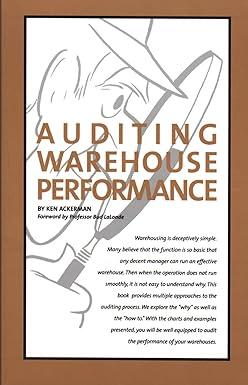Question
What internal controls might have prevented a former Smucker employee from stealing $4.1 million over 16 years? In October 2019, a former Smucker employee, Mark
What internal controls might have prevented a former Smucker employee from stealing $4.1 million over 16 years? In October 2019, a former Smucker employee, Mark Kershey, was charged with defrauding the J.M. Smucker Company of more than $4.1 million over a 16 year period. Kershey was the chief airplane mechanic at the companys hangar at the Akron-Canton Airport inOhio from 1990 until he was discharged by Smucker in 2018. From 1997 until he left Smucker,Kershey invoiced Smucker for more than $8.1 million by using a fictitious entity he created. Hebilled Smucker for nonexistent parts and/or work that he himself actually performed as part ofhis duties as a salaried employee. Most of these invoices were for less than $10,000, which Kershey himself was authorized to approve. A supervisor to Kershey approved the few invoices that were for more than $10,000 based on his trust in Kershey. To carry out his false billing scheme, Kershey set up a post office box in Lake Township in Ohio using the fictitious entity name of Aircraft Parts Services Co (APS). He (as APS) would then invoice Smucker using non-sequential invoice numbers, so it looked like APS was invoicing other companies too. Kershey used the proceeds to purchase and maintain two planes, several automobiles, and to make payments on his house. Kershey was eventually caught in late 2012 when three checks written by Smucker to APS totaling$44,000 were not cashed. When a Smucker employee questioned Kershey about the APS un-cashed checks, Kershey indicated that APS had been sold to another Smucker vendor. The false billing scheme began to unravel and Kershey was fired by Smucker. The Special Assistant United States Attorney has charged Kershey with mail fraud following an investigation by the Federal Bureau of Investigation, Canton, Ohio. Charges were filed in October 2019 and the case is pending. Questions:
1. What internal controls could have been used to prevent Kershey from carrying out the false billing scheme?
2. What factors might have contributed to the weak internal control environment that allowed this scheme to exist for 21 years?
Step by Step Solution
There are 3 Steps involved in it
Step: 1

Get Instant Access to Expert-Tailored Solutions
See step-by-step solutions with expert insights and AI powered tools for academic success
Step: 2

Step: 3

Ace Your Homework with AI
Get the answers you need in no time with our AI-driven, step-by-step assistance
Get Started


